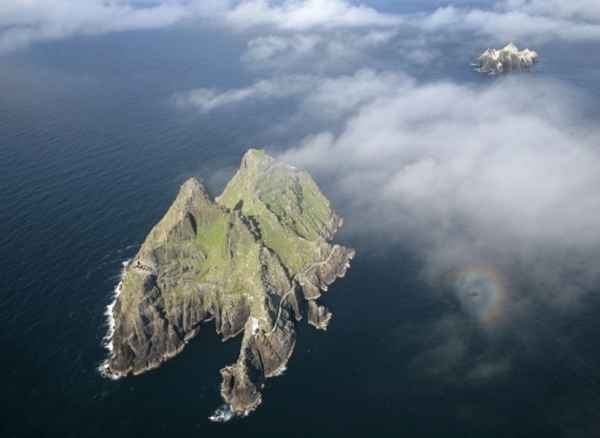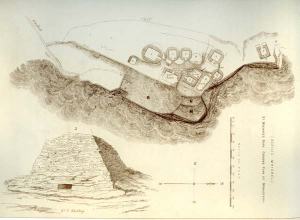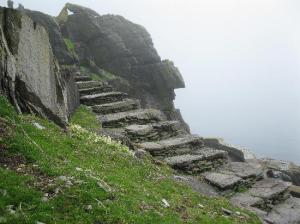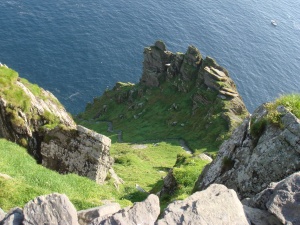
What do ancient Spanish invaders, Gannets and Luke Skywalker have in common? They have all set foot on the mystical and enchanting island of Skellig Michael.
Now famous both on Earth and in a galaxy far, far away, this world heritage site off of Ireland’s Ivereagh Peninsula in the Atlantic Ocean has a history dating back thousands of years.
ABOUT SKELLIG
Skellig Michael is one of two islands alongside Small Skellig which make up the Skellig Islands, reachable by boat from the fishing village of Portmagee in County Kerry. The name derives from the Irish ‘Sceillic’ which means ‘Steep Rock.’
The name is not misleading as the imposing natural formation stands more than 700 feet above sea level.
Star Wars aside, Skellig Michael is noted for not only incredibly well preserved archaeological sites of interest, but for the incredible amount of breeding birds it is home to. Rare birds such as gannets, puffins and artic terns draw in Ornithologists from around the globe.
SKELLIG MICHAEL AND THE MILESIANS
The origins of Skellig Michael are shrouded in mystery; however there have been documented accounts of the craggy outpost in ancient texts and annals. One such event dates back to 1700 B.C.
King Milesius spent many years absent from his homeland of Spain in pursuit of greatness and knowledge in places such as Egypt. He was welcomed as a hero upon his return and drove out hostile nations attempting to gain control.
As Spain fell victim to famine, Milesius found himself heavily influenced by the words of Cachear the Druid as well as his own superstitious beliefs. In order to appease the gods and his people, the King ordered members of his family to head up a scouting mission to a green and bountiful land that became known as Ireland.
Although his sons were successful in their conquering of Ireland and Milesius himself came to be known as ‘The Father of the Irish Race’, the initial expedition party ended in tragedy. The Chief Leader was a son of Milesius, called Ir. Unlike those who followed in his footsteps, Ir was doomed to never set foot on the Irish mainland.
During a stormy crossing, his ship crashed with the waves onto the rocks of Skellig Michael and he and his crew were drowned, the unforgiving natural wonder their final resting place.
THE MONKS OF SKELLIG MICHAEL
Saint Finnian of Clonard, also known as Fionán, was one of Ireland’s first monastic saints and he was responsible for the education and training of the Twelve Apostles of Ireland in County Meath in the sixth century.
It is believed that during this time Fionán founded a monastery on Skellig due to its remoteness and isolation from civilization. The actual location of the monastery on the island was selected for durability and access to building materials.
It was sometime between here and the 11th century that the monastery and Church were dedicated to Saint Michael, giving the large rocky habitat its name.
Monks continued to live, work and pray in solitude on Skellig Michael, believing their removal from general society brought them closer to God. Nature had a different opinion however, and as the centuries passed, conditions on the island become intolerable.
In the 1200’s, the Order of St. Augustine relocated to Ballinskelligs Abbey, however Skellig Michael remained under their authority and became a site of pilgrimage until the dissolution of the Catholic Church in Ireland under the command of Queen Elizabeth I of England.
SUBSEQUENT HISTORY OF SKELLIG MICHAEL
Despite its isolated and hostile demean or, Skellig Michael was gaining European attention. It was known to the Spanish Armada during their attacks on the Irish Atlantic coastline and was documented on charts and maps of Europe during the Middle Ages.
In 1578, Queen Elizabeth granted the island of Skellig Michael to the Butler Family who maintained control for a further number of generations, until it was purchased by Irish authorities in the nineteenth century as a matter of maritime safety.
It was at this point that not one, but two lighthouses were built to combat the combination of stormy high seas and the perilous rocks that had caused the deaths of so many sailors – too late for Ir!
SKELLIG MICHAEL TODAY
Skellig Michael has become a must visit location for naturalists, ornithologists, archaeologists and tourists for decades, not being deterred by the cantankerous ocean crossing from the Kerry mainland or the intensely steep ascent.
Once there, the remains of the monastery, St. Michael’s Church, the Monk’s Graveyard and over a hundred crosses dominate the rugged landscape.
In order to ascend to the monastery, one must climb 618 steps where you will stand at more than 600 feet above sea level; however the reward far outweighs the endeavour as you stand surveying incredible scenery, one with the depth of Irish history, the elements and nature, not to mention standing on the same craggy, remote site as Luke Skywalker in Star Wars!
George Bernard Shaw describes Skellig Michael best by calling it an ‘Incredible, impossible, mad place…’
May the Force of Skellig Michael be with you.






Reblogged this on Die Goldene Landschaft.
Je découvre votre magnifique blog ce jour. Je suis une fan inconditionnelle de l’Irlande. Vos histoires sont passionnantes. Elles me font découvrir tant de choses. Merci beaucoup.
Sylvia de Suisse